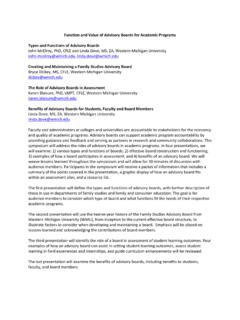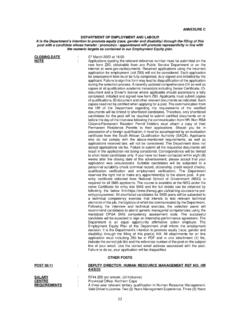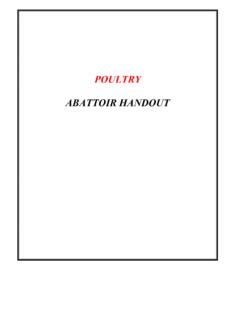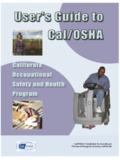Transcription of Family Life Education Content Areas: Content and Practice ...
1 National Council on Family Relations 2020 Family Life Education Content Areas: Content and Practice Guidelines (2020) These guidelines represent the Content from the National Council on Family Relations (NCFR) University and College Curriculum Guidelines and the Competencies for Family Life Educators, which were developed by faculty at Weber State University. It represents the knowledge, skills, and abilities identified as necessary for attainment of the Certified Family Life Educator (CFLE) credential. These Content areas include theory, research, and Practice within the field of Family Life Education . Examples of some of these core theories/frameworks/perspectives include Family systems, ecosystems, individual and Family development, exchange, symbolic interaction, conflict, feminist, and stress.
2 The Content areas are illustrated in the Lifespan Family Life Education (FLE) Framework (Bredehoft & Walcheski, 2011), which outlines all ten Content areas specific to four age groups: childhood, adolescence, adulthood, and older adulthood. The four age groups demonstrate the principle that FLE is relevant to individuals and families across the lifespan. The fact that FLE is inclusive of all audiences is represented by the words Value; Diverse Cultures, Communities, and Individuals; and Justice, that are woven throughout the framework. Additionally, FLE has a foundation in systems thinking (both Family systems and larger ecosystems) and this systems approach is represented by the words within the context of the Family system and reciprocal interactions between Family and ecosystem that also are woven throughout the framework.
3 In 2007 and again in 2014 NCFR, along with Schroeder Measurement Technologies (SMT) (now SMT/Prometric), conducted a job analysis survey which was distributed to current Certified Family Life Educators who were asked to rate the importance of each knowledge, skill, and ability in the Content outline to competent Practice . The results of the surveys were used to update the Content outline which represents the foundation of the CFLE credential as assessed through both the CFLE-approved program and exam processes. In 2020 the Content outline was further revised to align Content area objectives with Bloom s Taxonomy. There are two parts to each of the following 10 FLE Content areas. The first is Content which gives an overview of the subject matter included within each Content area. The second component includes Practice which relates to the tasks expected of an entry-level CFLE.
4 The Practice segment serves as the basis for questions on the CFLE exam. It also provides guidance to academic programs as they develop course objectives and learning outcomes. I. FAMILIES AND INDIVIDUALS IN SOCIETAL CONTEXTS (12% of exam) Content : An understanding of families and their relationships to other institutions, such as the educational, governmental, religious, health care, and occupational institutions in society. , Research and theories related to: Structures and Functions; Cultural Variations ( Family heritage, social class, geography, ethnicity, race & religion); Dating, Courtship, Marital Choice; Kinship; Cross-Cultural & Minority (understanding of lifestyles of minority families & the lifestyles of families in various societies around the world); Changing Gender Roles (role expectations & behaviors of courtship partners, marital partners, parents & children, siblings, & extended kin); National Council on Family Relations 2020 Demographic Trends; Historical Issues; Work/leisure & Family Relationships; Societal Relations (reciprocal influence of the major social institutions & families, , governmental, religious, educational, health care, & economic).
5 Practice A CFLE is prepared to: Describe the characteristics, diversity, and impact of local, national, and global social systems on individuals and families Explain factors ( , media, marketing, technology, economics, social movements, war, natural disasters, epidemics, environment, sustainability) influencing individuals and families from both contemporary and historical perspectives Describe factors that influence the relationship between work, personal, and Family life Articulate social and cultural influences affecting various aspects of Family life ( , dating, courtship, partner/marital choice and relationships, Family composition, divorce, and dying/death). Exemplify the reciprocal interaction between individuals, families, and various social systems ( , workplace, health, legal, educational, religious/spiritual) Assess the impact of demographics ( , class, race, ethnicity, religion, generation, gender, sexual orientation) on contemporary families II.
6 INTERNAL DYNAMICS OF FAMILIES (12% of exam) Content : An understanding of Family strengths and weaknesses and how Family members relate to and interact with each other. , Research & theories related to: Internal Social Processes (including cooperation & conflict); Communication (patterns & problems in couple relationships & in parent-child relationships, including stress & conflict management); Conflict Management; Decision-making and Goal-setting; Normal Family Stresses (transition periods in the Family life cycle, three-generation households, caring for the elderly, & dual careers); Family Stress & Crises (divorce, remarriage, death, economic uncertainty & hardship, violence, substance abuse); Special Needs in Families (including adoptive, foster, migrant, low income, military, & blended families as well as those members with ambiguous loss, chronic illness and/or disabilities).
7 Practice A CFLE is prepared to: Recognize and describe healthy and unhealthy characteristics pertaining to: o Family relationships o Family development Analyze Family functioning using various theoretical perspectives Analyze Family dynamics from a systems perspective Compare and contrast Family dynamics in response to normative and non-normative stressors Assess Family dynamics in response to stress, crises, and trauma Facilitate and strengthen communication processes, conflict-management, and problem-solving skills Describe, develop, and/or reinforce strategies that help families function effectively National Council on Family Relations 2020 III. HUMAN GROWTH AND DEVELOPMENT ACROSS THE LIFESPAN (12% of exam) Content : An understanding of the developmental changes (both typical and atypical) of individuals in families across the lifespan.
8 Based on knowledge of physical, emotional, cognitive, social, moral, and personality aspects. , Research and theories related to: Prenatal; Infancy; Early and Middle Childhood; Adolescence; and Adulthood (early, middle, and late). Practice A CFLE is prepared to: Explain developmental stages, transitions, elements, and challenges throughout the lifespan Illustrate reciprocal influences: o Individual development on families o Family development on individuals Describe and exemplify the impact of individual health and wellness on families Assist individuals and families in effective developmental transitions Apply appropriate practices based on theories of human growth and development to individuals and families Compare and contrast various socio-ecological influences on human development across the lifespan ( , sexual/gender identity, trauma, etc.)
9 IV. HUMAN SEXUALITY ACROSS THE LIFESPAN (8% of exam) Content : An understanding of the physiological, psychological, and social aspects of sexual development across the lifespan, to achieve healthy sexual adjustment. , Research and theories related to: Reproductive Physiology; Biological Determinants; Emotional and Psychological Aspects of Sexual Involvement; Sexual Behaviors; Sexual Values & Decision-Making; Family Planning; Physiological & Psychological Aspects of Sexual Response; Influence of Sexual Involvement on Interpersonal Relationships. Practice A CFLE is prepared to: Describe the biological aspects of human sexuality ( , sexual functioning, reproductive health, Family planning, sexually transmitted infections) Explain the psycho-social aspects of human sexuality: o Characteristics of healthy and unhealthy sexual relationships o Interpersonal dynamics of sexual intimacy o Risk factors ( , substance abuse, social pressures, media) Address human sexuality from value-respectful position o Apply best practices associated with sexuality Education programming V.
10 INTERPERSONAL RELATIONSHIPS (9% of exam) Content : An understanding of the development, maintenance, and dissolution of interpersonal relationships among friends, roommates, coworkers, neighbors, as well as Family members. National Council on Family Relations 2020 , Research and theories related to: Self and Others; Communication Skills (listening, empathy, self-disclosure, decision making, problem-solving, and conflict resolution); Forms of Intimacy, Love, and Romance; Relating to Others with Respect, Sincerity, and Responsibility. Practice A CFLE is prepared to: Describe the impact of personality and communication styles Explain the developmental stages of relationships Analyze interpersonal relationships using various theoretical perspectives Develop, implement, and assess relationship enhancement and enrichment strategies Develop, implement, and assess communication, problem solving, and anger and conflict management strategies Describe the impact of violence and coercion in interpersonal relationships Exemplify the influence of unhealthy coping strategies ( , substance use, disordered eating, avoidance) on interpersonal relationships VI.








